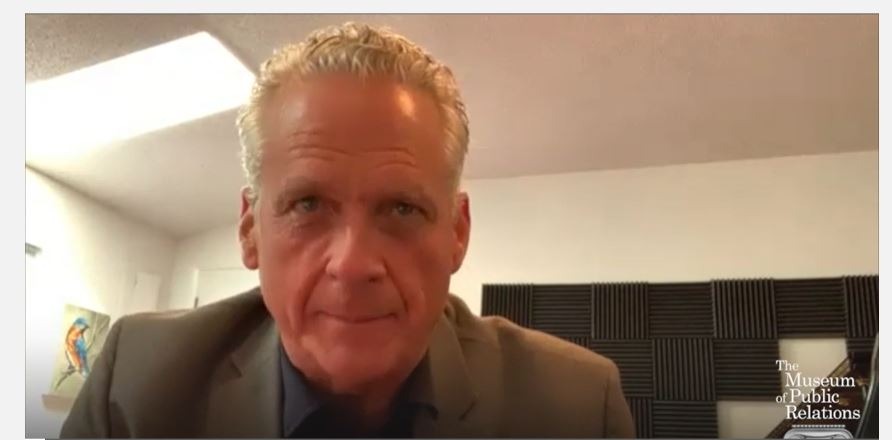Mark Ragan: Human-interest stories, crisp writing, and speechwriting among the top comms skills
The Ragan Communications owner offers guidance on career advancement, crisp writing, and how communicators can claim a more influential seat at the table during an interview with The Museum of PR.

Much has changed since Larry Ragan started producing a newsletter for corporate communicators in 1968.
However, the ability to whip up clear, concise writing remains an essential skill for communicators of all stripes.
“No matter how much tech you’ve mastered, it still comes back to simple, clear writing,” Mark Ragan says in a recent interview with The Museum of Public Relations. In the interview, Ragan shares a lifetime’s worth of expertise—much of which boils down to the power of brevity.
“Writing is now more concise, but it puts more emphasis on being able to write well,” Ragan says, referring to William Zinsser’s classic “On Writing Well” as the “Bible” for writers.
Clear communication also entails avoiding jargon and writing in a manner that reflects how a human being might speak. “Good writing is edited conversation,” Ragan says.
Of course, the job is not quite the same as it was when LBJ was in the Oval Office. Ragan says communicators today must become comfortable on both sides of the camera, be social media savvy and understand analytics. “The more of those things you know, the more marketable you’ll be,” Ragan says, noting that higher you rise, the more diverse a skill set you’ll need to master.
As you ascend, communicators should get a firmer grasp on bottom-line business strategy, financial literacy and speechwriting. And, if you want to truly shine, it’s about becoming more of an advisor rather than a mere messenger or order-taker.
Future-proofing your career
How can communicators cope with the rise of automation, AI and other more “respected” departments? Not to mention tightened, post-COVID budgets? Compelling human-interest stories never go out of style. “Brand journalism has exploded, and it’s still the future,” Ragan says.
This is about much more than PR. As the U.S. news media landscape continues to disintegrate and splinter, companies can fill a vital information void. It’s the perfect time to start telling your own stories and create your own go-to news platform, as businesses are actually among the most trusted U.S. institution right now.
Ragan clarifies that press releases and posting videos won’t suffice. Brand journalism is about crafting robust, objective storytelling with expert sources. It’s about sharing news your specific audience will care about—and surfacing those fascinating internal stories that might require a bit of digging.
Citing examples of brand journalism in action, Ragan shares how Pittsburgh International Airport has become an industry leader in aviation news—even breaking stories local outlets subsequently chase after. Cape Cod Health has its news syndicated. Advocate Health Care, Ragan’s first brand journalism site, has garnered well north of 100,000 opt-in subscribers, while Denver Water’s “Tap” site continues to “hydrate the minds” of its readers with wonderful, behind-the-scenes storytelling of how water flows in The Centennial State.
American Express’ “Open Forum,” which functions as a news service for small businesses, is another source of brand journalism inspiration. Whatever your industry, find your narrow niche and provide meaningful service journalism—not “propaganda,” as Ragan puts it. And try to come up with a catchier name than “The House Organ,” which Ragan says used to be the awkward moniker of Ford’s internal newsletter back in his dad’s day.
“If you do it right, the media will chase after you,” Ragan says.
Brand journalism also presents a more compelling proposition for your employees. Your comms team will relish the challenge of finding and sharing vivid stories about their colleagues—and your workers will certainly enjoy reading about themselves.
Being a bold truth-teller
Speaking to younger comms pros, Ragan emphasizes the importance of transparency. “Don’t try to hide crises or play it down. Be a transparent truth-teller,” he says.
Of course, that’s easier said than done. But it’s that sort of backbone that will help communicators ascend in their careers to become respected decision makers and policy shapers. It’s also the sort of mettle that’s helped communicators expand their influence during the past year of turmoil, chaos and tragedy.
“Internal comms used to be ‘shut up and work.’ ‘There’s your desk, stop complaining,’” Ragan says, but the crises of 2020 have pushed communicators into the forefront of organizational strategy. The trick is maintaining that momentum in 2021 and beyond.
To do so, Ragan recommends staying on top of current events and learning new skills relevant to ESG, DE&I and CSR topics. Speechwriting is another crucial skill to learn moving forward. Ragan says: “You wield immense power and influence if you shape an exec’s thoughts and words.”
In addition to crisis comms skills, these are the sorts of thorny topics that execs increasingly seek advice on.
“The C-suite will always need wise counsel,” Ragan says, citing the racial reckoning and voting rights issues of the past year. The top communicators will have the backbone to correct, guide and prod execs to speak up (or hush) when need be.
However, don’t expect to absorb all this expertise on the fly. “Much of this you learn as you go, as gray hairs pop up on your scalp,” Ragan says.
Despite the upheaval of the past year, Ragan is sanguine about the future of comms and PR as a profession. He believes that if you’re a good, well-rounded writer and well-informed, you’ll go places.
“Imagine the pandemic without internal communicators? Where would we be?” he says.
Surely, many companies would have been forced to fold without communicators keeping it all together.
As Ragan puts it: “Communicators now pull the strings, shape corporate messaging, and keep cultures afloat. Internal comms is a great field to go into.”







